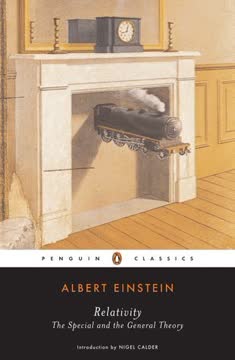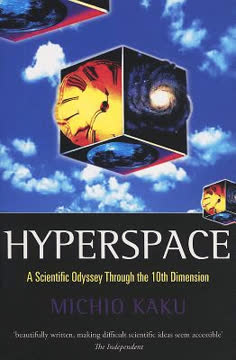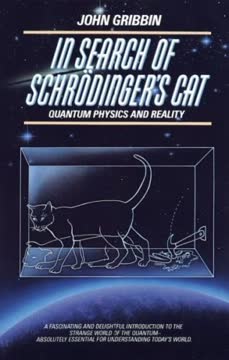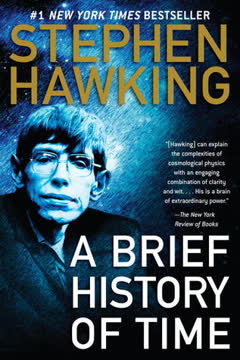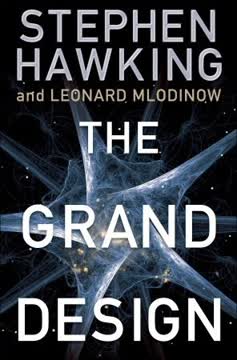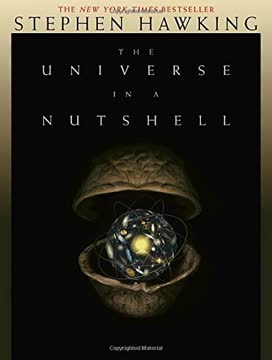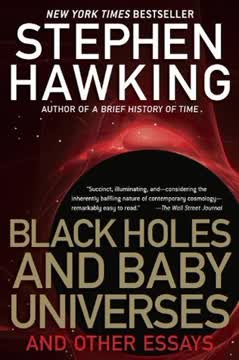Klíčové body
1. Vesmír je mnohem složitější a tajemnější, než si dokážeme představit
"Jaké místo tedy zbývá pro tvůrce?"
Odhalení kosmické složitosti. Práce Stephena Hawkinga zásadně zpochybňuje naše tradiční chápání vesmíru a odhaluje jej jako složitý, dynamický systém, který daleko přesahuje lidské chápání. Vesmír není statickou entitou, ale neustále se vyvíjejícím, komplexním mechanismem řízeným složitými fyzikálními zákony.
Klíčové poznatky o univerzální složitosti:
- Vesmír funguje na škálách a principech, které odporují každodenní lidské zkušenosti
- Základní fyzikální zákony jsou propojeny způsoby, které teprve začínáme chápat
- Naše vnímání reality je omezeno našimi smyslovými a kognitivními schopnostmi
Filozofické důsledky. Složitost vesmíru naznačuje, že naše tradiční náboženské a vědecké rámce jsou nedostatečné pro plné pochopení jeho povahy. Hawkingova práce naznačuje, že vesmír by mohl být samovytvářející, což zpochybňuje dlouho udržované víry o stvoření a božské intervenci.
2. Gravitace a expanze zásadně přetvářejí naše chápání kosmických počátků
"Expanding universe neznamená, že by tvůrce byl vyloučen, ale klade to meze na to, kdy mohl vykonat svou práci."
Gravitační dynamika. Hawking vysvětluje, jak gravitace není jen jednoduchou přitažlivou silou, ale komplexním jevem, který formuje samotnou strukturu časoprostoru. Expanze vesmíru, poháněná gravitačními interakcemi, odhaluje dynamickou kosmickou krajinu, která se neustále proměňuje.
Mechanismy expanze:
- Galaxie se od sebe vzdalují úměrnými rychlostmi
- Rychlost expanze určuje konečný osud vesmíru
- Gravitace ovlivňuje formování kosmické struktury
Transformativní perspektivy. Chápání univerzální expanze zpochybňuje statické kosmické modely, naznačuje, že vesmír není pevnou entitou, ale neustále se vyvíjejícím systémem s inherentními matematickými a fyzikálními principy, které řídí jeho chování.
3. Černé díry zpochybňují vše, co víme o fyzice
"Černé díry nejsou tak černé, jak se zdají."
Revoluční koncept. Černé díry představují mimořádné kosmické jevy, které zpochybňují tradiční chápání fyziky. Nejsou to jen masivní objekty, které pohlcují vše, ale komplexní systémy, které vyzařují záření a potenciálně mění naše chápání časoprostoru.
Charakteristiky černých děr:
- Vyzařují záření (na rozdíl od počátečních teorií)
- Mají specifické matematické vlastnosti
- Zpochybňují limity klasické fyziky
- Představují potenciální brány k pochopení kvantové mechaniky
Vědecký posun paradigmat. Černé díry ukazují, že naše současné fyzikální teorie jsou neúplné a vyžadují inovativní přístupy, které integrují kvantovou mechaniku a obecnou relativitu.
4. Kvantová mechanika odhaluje hluboké poznatky o prostoru a čase
"Rozdíl mezi časem a prostorem zcela mizí."
Kvantová revoluční perspektiva. Kvantová mechanika zavádí radikální koncepty o povaze reality, naznačuje, že čas a prostor jsou mnohem fluidnější a propojenější, než jsme si dříve mysleli. Tato teorie zpochybňuje lineární vnímání kauzality a dimenzionality.
Kvantové poznatky:
- Čas lze koncepčně chápat jako "imagární"
- Chování částic odporuje klasickým deterministickým modelům
- Neurčitost je základním principem vesmíru
- Pozorování ovlivňuje kvantové systémy
Filozofické důsledky. Kvantová mechanika naznačuje, že realita je pravděpodobnostní, nikoli deterministická, s fundamentální neurčitostí zakotvenou v samotné podstatě existence.
5. Velký třesk je víc než jen okamžik stvoření
"Začátek času by byl pravidelným hladkým bodem časoprostoru."
Kosmická geneze znovu promyšlená. Velký třesk není jednoduchou explozivní událostí, ale komplexním kvantově mechanickým procesem, který představuje přechod vesmíru z neurčitého stavu do pozorovatelné existence.
Charakteristiky Velkého třesku:
- Vznikl z kvantových fluktuací
- Řídil se přesnými matematickými principy
- Představoval transformaci, nikoli doslovnou "explozivní událost"
- Počáteční stav byl vysoce uspořádaný a homogenní
Vědecká nuance. Pochopení Velkého třesku vyžaduje překonání zjednodušených narativních modelů, abychom porozuměli sofistikovaným kvantově mechanickým procesům, které leží v základu kosmického vzniku.
6. Vědecké teorie se vyvíjejí prostřednictvím neustálého zpochybňování
"Vědecká teorie je jen matematický model, který vytváříme, abychom popsali naše pozorování."
Dynamika vědeckého pokroku. Vědecké chápání pokročuje nikoli prostřednictvím absolutní jistoty, ale prostřednictvím neustálého zpochybňování, vyzývání stávajících modelů a rozvoje sofistikovanějších vysvětlení.
Principy evoluce teorií:
- Teorie jsou dočasné, nikoli trvalé
- Vědecký pokrok vyžaduje skepticismus
- Matematické modely pomáhají vysvětlit pozorování
- Teorie se zpřesňují s novými důkazy
Intelektuální pokora. Hawking zdůrazňuje, že vědecké poznání je vždy dočasné, vyžadující neustálé zkoumání a ochotu revidovat stávající chápání.
7. Hledání sjednocené teorie všeho pokračuje
"Fyzika, jak ji známe, skončí za šest měsíců."
Teoretická hranice. Hledání komplexní teorie, která vysvětluje všechny fyzikální interakce, zůstává trvalou vědeckou výzvou, vyžadující integraci kvantové mechaniky, relativity a dalších základních fyzikálních principů.
Výzvy sjednocené teorie:
- Vyžaduje usmíření zdánlivě neslučitelných teorií
- Požaduje inovativní matematické rámce
- Nezbytné je pochopení kvantových gravitačních efektů
- Zahrnuje komplexní interdisciplinární výzkum
Intelektuální zkoumání. Usilování o sjednocenou teorii představuje nejambicióznější pokus lidstva pochopit základní principy vesmíru.
8. Lidské vnímání je omezené v chápání kosmické složitosti
"Minulost je cizí země. Dělají tam věci jinak."
Vnímací omezení. Lidské kognitivní schopnosti jsou inherentně omezené v chápání kosmických měřítek a složitých fyzikálních jevů, což vyžaduje sofistikované matematické a teoretické přístupy.
Omezení vnímání:
- Smyslové systémy se vyvinuly pro přežití, nikoli pro kosmické porozumění
- Matematické modely překračují přímé pozorování
- Intuice často klame v kvantových a kosmologických oblastech
Epistemologický vhled. Pochopení vesmíru vyžaduje překonání okamžité smyslové zkušenosti a rozvoj sofistikovaných konceptuálních rámců.
9. Náhodnost a pravděpodobnost formují univerzální dynamiku
"Zákony fyziky nerozlišují mezi minulostí a budoucností."
Pravděpodobnostní vesmír. Univerzální dynamika je v zásadě pravděpodobnostní, přičemž neurčitost a náhodné fluktuace hrají klíčové role v kosmické evoluci.
Pravděpodobnostní principy:
- Kvantová mechanika zavádí základní neurčitost
- Chování částic je pravděpodobnostní
- Kosmická evoluce zahrnuje komplexní statistické procesy
Filozofické důsledky. Náhodnost není absencí pořádku, ale základním organizačním principem kosmické složitosti.
10. Naše chápání vesmíru se neustále proměňuje
"Nemůžete předpovědět budoucnost, pouze pravděpodobnost různých výsledků."
Dynamická krajina znalostí. Vědecké chápání vesmíru se neustále vyvíjí, přičemž každý objev odhaluje nové vrstvy složitosti a zpochybňuje stávající paradigmy.
Charakteristiky evoluce znalostí:
- Vědecké modely se neustále zpřesňují
- Nové technologie umožňují hlubší pozorování
- Interdisciplinární přístupy generují nové poznatky
- Intelektuální pokora je klíčová pro pokrok
Nepřetržité učení. Vesmír zůstává otevřenou knihou, přičemž každý vědecký průlom nabízí pohledy do jeho hluboké, tajemné povahy.
Poslední aktualizace:
FAQ
What's "The Theory of Everything: The Origin and Fate of the Universe" about?
- Overview: The book, authored by Stephen Hawking, explores the history and future of the universe, from the big bang to black holes.
- Content Structure: It is structured as a series of lectures that cover various cosmological concepts and theories.
- Main Themes: The book delves into the nature of the universe, the laws of physics, and the quest for a unified theory that explains everything.
- Purpose: It aims to make complex scientific ideas accessible to a general audience, providing insights into the workings of the universe.
Why should I read "The Theory of Everything: The Origin and Fate of the Universe"?
- Understanding the Universe: It offers a comprehensive overview of the universe's history and future, making it essential for anyone interested in cosmology.
- Accessible Science: Hawking presents complex scientific concepts in an understandable manner, making it suitable for readers without a scientific background.
- Intellectual Curiosity: The book stimulates curiosity about the fundamental questions of existence and the universe.
- Influential Work: As a work by Stephen Hawking, it provides insights from one of the most renowned physicists of our time.
What are the key takeaways of "The Theory of Everything: The Origin and Fate of the Universe"?
- Big Bang and Black Holes: The book explains the origins of the universe with the big bang and the nature of black holes.
- Unified Theory: It discusses the quest for a unified theory that combines quantum mechanics and general relativity.
- Time and Space: Hawking explores the concepts of time, space, and the possibility of a universe without boundaries.
- Scientific Inquiry: The book emphasizes the importance of scientific inquiry and the ongoing search for understanding the universe.
What are the best quotes from "The Theory of Everything: The Origin and Fate of the Universe" and what do they mean?
- "The universe would be neither created nor destroyed. It would simply be." This quote reflects the idea of a self-contained universe without a beginning or end.
- "The boundary condition of the universe is that it has no boundary." It suggests a universe that is finite yet unbounded, challenging traditional notions of time and space.
- "If we find the answer to that, it would be the ultimate triumph of human reason." This highlights the pursuit of a complete understanding of the universe as a pinnacle of human achievement.
- "The past is a foreign country. They do things differently there." This quote, borrowed from L.P. Hartley, underscores the book's exploration of time's direction and nature.
How does Stephen Hawking explain the Big Bang in "The Theory of Everything"?
- Initial Singularity: Hawking describes the big bang as a singularity where the universe's density and temperature were infinite.
- Expansion: He explains that the universe has been expanding since the big bang, leading to the formation of galaxies and stars.
- Time's Beginning: The big bang marks the beginning of time, as events before it have no observational consequences.
- Scientific Evidence: Hawking supports the big bang theory with evidence such as cosmic microwave background radiation.
What is the significance of black holes in "The Theory of Everything"?
- Gravitational Collapse: Black holes are formed when massive stars collapse under their own gravity, creating regions from which nothing can escape.
- Event Horizon: The boundary of a black hole, known as the event horizon, marks the point beyond which escape is impossible.
- Hawking Radiation: Hawking introduces the concept of black holes emitting radiation, challenging the notion that they are completely black.
- Cosmic Mysteries: Black holes are central to understanding the universe's structure and the laws of physics.
What is the "no boundary" proposal in "The Theory of Everything"?
- Finite but Unbounded: The proposal suggests that the universe is finite in extent but has no boundaries, similar to the surface of the Earth.
- Imaginary Time: It involves the concept of imaginary time, where time and space are indistinguishable, eliminating singularities.
- Self-Contained Universe: The universe is self-contained, without the need for external creation or destruction.
- Implications for Creation: This challenges traditional views of creation, suggesting a universe that simply exists.
How does "The Theory of Everything" address the concept of time?
- Time's Direction: Hawking explores why time seems to have a direction, known as the arrow of time, linked to the universe's expansion.
- Thermodynamic Arrow: The increase of disorder or entropy over time gives time its direction.
- Psychological Arrow: Our perception of time aligns with the thermodynamic arrow, as we remember the past but not the future.
- Cosmological Arrow: The universe's expansion provides a cosmological arrow of time, influencing the other arrows.
What role does quantum mechanics play in "The Theory of Everything"?
- Uncertainty Principle: Quantum mechanics introduces the uncertainty principle, affecting the predictability of events.
- Quantum Gravity: Hawking discusses the need for a quantum theory of gravity to understand the universe's early stages.
- Virtual Particles: The concept of virtual particles and their role in black hole radiation is explored.
- Unified Theory: Quantum mechanics is essential in the quest for a unified theory that combines all fundamental forces.
How does Stephen Hawking approach the search for a unified theory in "The Theory of Everything"?
- Grand Unified Theories: The book discusses theories that combine the weak, strong, and electromagnetic forces but not gravity.
- Challenges: The main challenge is integrating gravity, described by general relativity, with quantum mechanics.
- String Theory: Hawking explores string theory as a potential framework for a unified theory.
- Ultimate Goal: The search for a unified theory aims to provide a complete understanding of the universe's laws.
What is the anthropic principle as discussed in "The Theory of Everything"?
- Human-Centric View: The anthropic principle suggests that the universe's properties are as they are because they allow for the existence of intelligent life.
- Selection Principle: It implies that we observe the universe in a way that supports life because we are here to observe it.
- Cosmological Implications: The principle is used to explain why the universe appears fine-tuned for life.
- Philosophical Considerations: It raises questions about the role of observers in defining the universe's characteristics.
How does "The Theory of Everything" explore the relationship between science and philosophy?
- Scientific Inquiry: Hawking emphasizes the importance of scientific inquiry in understanding the universe.
- Philosophical Questions: The book addresses philosophical questions about existence, creation, and the nature of reality.
- Limits of Science: It acknowledges the limits of scientific models in answering "why" questions about the universe.
- Interdisciplinary Dialogue: Hawking encourages dialogue between science and philosophy to explore fundamental questions.
Recenze
Teorie všeho je chválena za své srozumitelné vysvětlení složitých kosmologických konceptů, i když někteří čtenáři považovali za obtížné ji pochopit bez předchozích znalostí fyziky. Hawkingův vtip a pokora jsou velmi ceněny. Kniha se zabývá původem vesmíru, černými dírami a hledáním sjednocující teorie. Mnozí recenzenti ji doporučují pro ty, kteří se zajímají o astronomii a fyziku, a zdůrazňují její stručnost a přitom komplexnost. Někteří naznačují, že pro plné pochopení obsahu může být potřeba knihu přečíst vícekrát.

